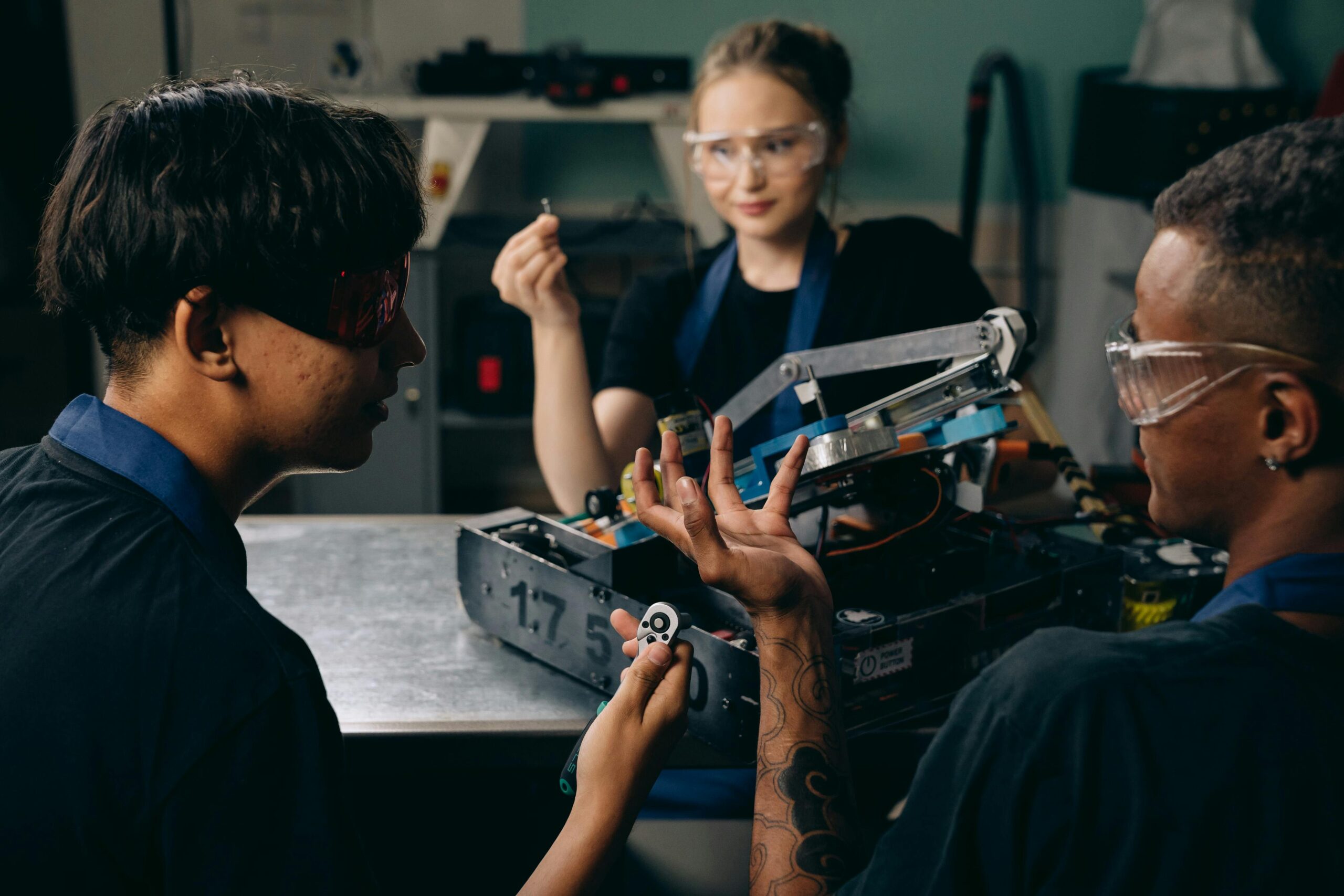Collaborative robots are reshaping modern manufacturing by working safely alongside human workers, boosting productivity, efficiency, and flexibility across industries worldwide.
🤖 The Dawn of a New Manufacturing Era
The manufacturing landscape is experiencing a profound transformation. Traditional industrial robots, once confined to safety cages and isolated workstations, dominated factory floors for decades. These powerful machines excelled at repetitive tasks but required significant infrastructure, programming expertise, and safety measures that kept humans at a distance. Today, a new generation of robotics technology is breaking down these barriers and redefining what automation means for manufacturers of all sizes.
Collaborative robots, affectionately known as cobots, represent a paradigm shift in how we approach industrial automation. Unlike their predecessors, these intelligent machines are designed from the ground up to work harmoniously with human operators, combining the precision and consistency of robotics with human creativity, problem-solving abilities, and adaptability. This synergy is unlocking unprecedented opportunities for businesses seeking to remain competitive in an increasingly globalized marketplace.
Understanding What Makes Cobots Different
The distinction between traditional industrial robots and collaborative robots extends far beyond their ability to share workspace with humans. Cobots incorporate advanced sensor technologies, force-limiting capabilities, and intuitive programming interfaces that fundamentally change how manufacturers implement automation solutions. These machines can detect unexpected contact and immediately reduce force or stop movement entirely, ensuring operator safety without compromising productivity.
Size and portability represent another critical differentiator. While conventional robots often weigh several tons and require permanent installation with extensive floor modifications, cobots are typically lightweight and mounted on mobile bases or easily repositioned. This flexibility allows manufacturers to redeploy automation assets as production needs evolve, maximizing return on investment and adapting quickly to market demands.
Key Technical Advantages 🔧
Modern collaborative robots incorporate sophisticated technologies that enable their safe operation alongside humans. Advanced vision systems allow cobots to identify parts, navigate complex environments, and adjust their movements in real-time. Force-torque sensors continuously monitor applied pressure, ensuring delicate components aren’t damaged and human operators remain safe during incidental contact.
The programming revolution deserves special attention. Traditional robots required specialized programming languages and expert technicians who spent weeks configuring complex movement sequences. Cobots employ intuitive interfaces where operators physically guide the robot arm through desired movements, which the system records and replicates. This “teach by demonstration” approach dramatically reduces implementation time and empowers shop floor workers to become automation programmers.
Transforming Small and Medium Manufacturing Enterprises
Perhaps nowhere is the cobot revolution more impactful than in small and medium-sized enterprises (SMEs). For decades, automation remained largely inaccessible to smaller manufacturers due to prohibitive costs, complexity, and inflexibility. The initial investment for traditional robotic cells could easily exceed hundreds of thousands of dollars, with additional expenses for safety infrastructure, specialist programming, and ongoing maintenance.
Cobots have democratized automation by reducing these barriers substantially. Entry-level collaborative robots now start at price points comparable to an average annual worker salary, making the business case compelling even for companies with modest production volumes. The rapid deployment capability means manufacturers can achieve return on investment within months rather than years, fundamentally changing the economic calculation around automation adoption.
Real-World SME Success Stories 📈
A family-owned precision machining company in Germany exemplifies this transformation. Facing skilled labor shortages and increasing competition from low-cost regions, they deployed cobots to handle repetitive machine tending operations. Within six months, production capacity increased by 35% while allowing their experienced machinists to focus on complex setups and quality control. The company reports that worker satisfaction actually improved, as employees escaped monotonous tasks and engaged in more skilled, fulfilling work.
Similarly, a bakery equipment manufacturer in Wisconsin implemented collaborative robots for welding applications. Previously, they struggled to find qualified welders and maintain consistent quality across production runs. Their cobot solution delivers perfect welds repeatedly while human workers prepare materials and perform finishing operations. Production consistency improved dramatically, warranty claims decreased by 40%, and the company expanded into new markets based on their enhanced manufacturing capabilities.
Applications Across Manufacturing Sectors
The versatility of collaborative robots enables deployment across virtually every manufacturing sector. Their adaptability to different tasks, quick changeover capabilities, and modest footprint make them ideal for the varied, small-batch production increasingly demanded by modern markets.
Automotive Manufacturing 🚗
The automotive industry, an early adopter of traditional robotics, has embraced cobots for applications requiring flexibility and precision. Assembly operations involving delicate components, quality inspection tasks utilizing advanced vision systems, and finishing work like polishing and deburring benefit tremendously from collaborative automation. Major automotive suppliers report that cobots complement their existing automation infrastructure, filling gaps where traditional robots proved too inflexible or expensive to justify.
Electronics Assembly
Electronics manufacturing presents unique challenges including microscopic components, frequent product changes, and exacting quality standards. Cobots equipped with precision grippers and vision systems excel at circuit board assembly, component placement, and testing operations. Their ability to work in cleanroom environments and handle electrostatic-sensitive components makes them invaluable partners in producing everything from smartphones to medical devices.
Food and Beverage Production 🍕
Food safety regulations and hygiene requirements once made automation challenging in food processing facilities. Modern collaborative robots designed with food-grade materials, sealed joints, and easy-cleaning surfaces now meet stringent sanitation standards. Applications include packaging, palletizing, quality inspection, and even food preparation tasks. The consistency cobots bring to portioning, decorating, and assembly operations ensures uniform products while protecting workers from repetitive strain injuries.
The Human Element: Workforce Transformation
Concerns about automation displacing workers dominate public discourse around robotics. However, real-world implementation of collaborative robots tells a more nuanced story. Rather than wholesale job elimination, cobots typically augment human capabilities, taking over physically demanding or monotonous tasks while elevating workers to supervisory, quality control, and problem-solving roles.
Progressive manufacturers view cobots as tools for attracting and retaining talent in an era of persistent skilled labor shortages. Younger workers, comfortable with technology and seeking engaging work, find cobot-assisted manufacturing more appealing than traditional factory positions. Companies implementing collaborative robots report improved employee retention, reduced workplace injuries, and higher job satisfaction scores.
Upskilling and Workforce Development 💡
The cobot revolution demands new skills but creates pathways for workforce advancement. Operators learn robot programming, maintenance, and optimization—capabilities that increase their value and earning potential. Forward-thinking manufacturers partner with technical colleges and community organizations to develop cobot training programs, ensuring pipeline of qualified talent while demonstrating commitment to community development.
This transition isn’t without challenges. Change management requires thoughtful communication, comprehensive training, and genuine engagement with workers who understandably feel anxious about automation. Manufacturers achieving greatest success involve employees early in cobot selection and implementation, demonstrating how automation enhances rather than threatens their roles.
Economic Impact and Return on Investment
Financial justification drives manufacturing decisions, and collaborative robots deliver compelling economic benefits extending beyond simple labor cost comparisons. While reduced labor expenses contribute to ROI calculations, the full value proposition encompasses quality improvement, increased throughput, enhanced flexibility, and reduced workplace injuries.
Typical cobot implementations achieve payback periods between 6-18 months, remarkably short compared to traditional automation projects. This rapid return stems from multiple factors: lower initial investment, minimal infrastructure requirements, quick deployment, and redeployment flexibility. As production needs change, cobots move to new applications rather than becoming stranded assets—a critical advantage in dynamic market conditions.
Calculating Total Cost of Ownership 📊
Comprehensive ROI analysis must consider all cost factors. Collaborative robots require less maintenance than traditional automation due to simpler mechanical designs and fewer complex components. Energy consumption typically measures a fraction of conventional industrial robots. Programming and changeover speed reduces downtime between production runs, maximizing productive hours.
Quality improvements often deliver unexpected financial benefits. Consistent, precise cobot operation reduces scrap, rework, and warranty claims. Manufacturers report defect rates dropping by 50-80% on cobot-assisted production lines. For industries with tight margins, these quality gains alone can justify automation investment.
Overcoming Implementation Challenges
Despite their advantages, successful cobot deployment requires careful planning and realistic expectations. Common implementation pitfalls include inadequate application assessment, unrealistic performance expectations, insufficient training, and poor integration with existing equipment and workflows.
Effective implementations begin with thorough process analysis identifying tasks genuinely suitable for collaborative automation. Not every operation benefits from cobot assistance—highly variable tasks requiring constant human judgment, for instance, may prove difficult to automate effectively. Starting with clear, repeatable processes ensures initial success that builds organizational confidence and expertise.
Integration and Ecosystem Considerations 🔗
Cobots don’t operate in isolation. Successful deployments integrate with existing manufacturing execution systems, quality management platforms, and production equipment. Standardized communication protocols like OPC-UA facilitate this integration, but manufacturers must still invest time configuring data flows, establishing monitoring dashboards, and creating maintenance procedures.
The growing cobot ecosystem includes specialized end-effectors, vision systems, force sensors, and accessories that expand capabilities. Selecting appropriate tools for specific applications requires understanding both current needs and future expansion possibilities. Modular approaches allow incremental capability additions as operators gain experience and identify new opportunities.
Looking Ahead: The Future of Collaborative Robotics 🚀
Technological advancement continues accelerating in collaborative robotics. Artificial intelligence and machine learning increasingly enable cobots to handle more complex, variable tasks with minimal programming. Vision systems achieve near-human object recognition capabilities, allowing robots to work with unstructured parts and adapt to variations in component positioning or orientation.
The next generation of cobots will exhibit even greater autonomy, learning from demonstrations and optimizing their own movements for efficiency and quality. Cloud connectivity enables fleet management, predictive maintenance, and collective learning where insights from one robot benefit entire networks. These capabilities will further reduce implementation barriers and expand the range of applications suitable for collaborative automation.
Emerging Applications and Industries
Sectors traditionally resistant to automation are discovering cobot applications. Healthcare facilities deploy collaborative robots for laboratory sample handling, pharmacy dispensing, and logistics. Agriculture explores cobots for harvesting, pruning, and packaging operations. Construction companies pilot collaborative systems for bricklaying, welding, and material handling on job sites.
As capabilities expand and costs continue declining, cobots will penetrate deeper into manufacturing operations and extend into entirely new domains. The fundamental value proposition—safe human-robot collaboration combining the strengths of both—positions collaborative robotics as a cornerstone technology for the factories and workplaces of tomorrow.
Making the Strategic Decision for Your Operation
Manufacturers considering collaborative robots should approach the decision strategically rather than viewing cobots as simple plug-and-play solutions. Begin by identifying high-value applications where automation delivers measurable benefits: quality improvement, capacity expansion, worker safety enhancement, or capability creation enabling new product offerings.
Engage your workforce early and authentically. Operators possess invaluable insights about process challenges and improvement opportunities. Their buy-in proves essential for successful implementation and ongoing optimization. Frame cobot adoption as empowering workers rather than replacing them, emphasizing skill development and role enhancement.
Partner with experienced integrators who understand your industry’s specific requirements and can provide comprehensive support from application assessment through deployment and beyond. While cobots simplify automation, expertise still matters in selecting appropriate hardware, designing effective work cells, and optimizing performance.

The Collaborative Manufacturing Revolution Continues ✨
Collaborative robotics represents more than incremental improvement in manufacturing automation—it fundamentally reimagines the relationship between humans and machines in production environments. By enabling safe, productive collaboration, cobots unlock automation benefits for manufacturers previously unable to justify traditional robotics while providing established automated facilities with new flexibility and capabilities.
The transformation is accelerating as technology advances, costs decline, and successful implementations demonstrate compelling value. Manufacturers embracing collaborative robotics position themselves advantageously for an increasingly competitive global marketplace where flexibility, quality, and innovation determine winners and losers.
Whether you operate a family-owned workshop or manage production facilities for a multinational corporation, collaborative robots offer tangible pathways to enhanced competitiveness, improved working conditions, and sustainable growth. The cobot revolution isn’t coming—it’s already here, transforming manufacturing one collaborative application at a time.
Toni Santos is a future-of-work researcher and social innovation writer exploring how technology, culture, and global mobility are redefining what it means to work and thrive in the 21st century. Through his studies on automation, digital nomadism, and workforce transformation, Toni examines the balance between progress, adaptability, and human purpose in a rapidly changing world. Passionate about remote collaboration systems and digital inclusion, Toni focuses on how emerging tools and global connectivity empower individuals to build meaningful, flexible, and resilient careers. His work highlights how automation and new work models can coexist with creativity, empathy, and social value. Blending sociology, economics, and digital strategy, Toni writes about the human side of innovation — helping readers understand not only where work is heading, but how to align with its transformation responsibly and purposefully. His work is a tribute to: The evolving relationship between automation and human employment The rise of global, location-independent lifestyles The power of resilience and adaptability in the modern workforce Whether you are a freelancer, remote leader, or curious observer of the new economy, Toni Santos invites you to explore the future of work — one idea, one connection, one transformation at a time.




